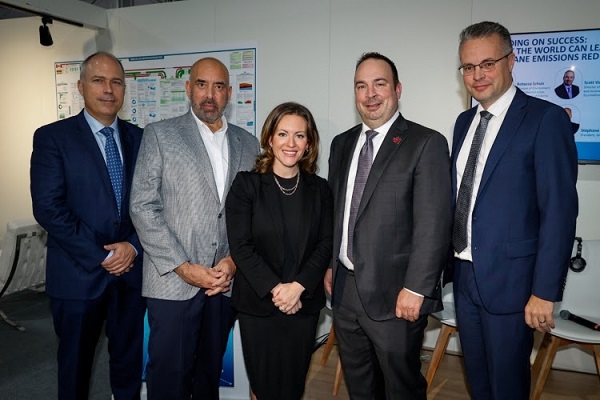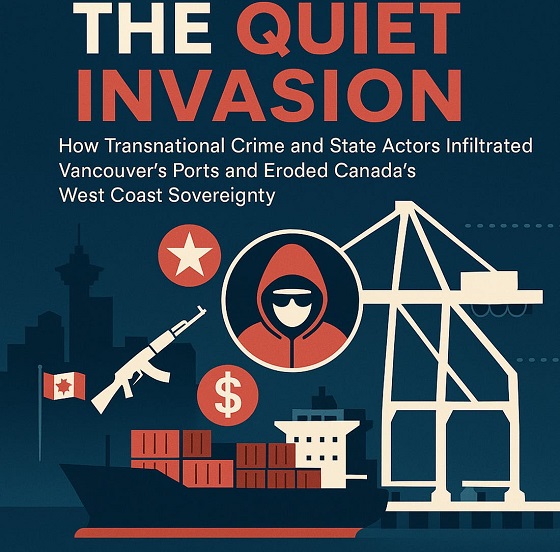Alberta
Turning resources into new jobs and products

(Left to right: Stéphane Germain, president of GHGSat; John Adams, president and CEO, NGIF Capital and NGIF Accelerator and managing partner of Cleantech Ventures; Rebecca Schulz, Minister of Environment and Protected Areas; Scott Volk, director of emissions and innovation, Tourmaline Oil; Justin Riemer, CEO of Emissions Reduction Alberta)
New funding will advance technologies that turn Alberta’s natural resources, such as bitumen, into materials of the future.
Alberta is Canada’s third-largest producer of manufactured goods and materials and first in clean technology innovation. At the same time, manufacturing companies around the world are looking for ways to make products like concrete, plastics, food, wood, chemicals and machinery more efficient, more durable, easier to recycle and better for the environment.
Alberta’s government is investing $40 million from the industry-funded Technology Innovation and Emissions Reduction (TIER) program to advance technologies that will turn everyday items that would otherwise be wasted or dumped in landfills into modern, low-emission products. These technologies will help create jobs, reduce emissions and help Alberta’s manufacturing industry lead the world.
“We have the resources, expertise and entrepreneurs needed to create some of the most advanced materials in the world. This funding competition will help develop new and exciting technologies that reduce emissions, create jobs, reuse waste and keep growing our economy.”
Advanced materials are increasing in global demand. They are new or significantly improved materials that provide a distinct advantage in performance when compared to conventional materials. Advanced materials have already been used to create new construction materials, improved batteries and fuel cells and lighter, stronger aircrafts, bicycles and golf clubs, among other products.
Led by Emissions Reduction Alberta, Alberta’s new funding competition will support scale-up, pilot, and demonstration and first-of-kind commercial technologies that improve the extraction, production, manufacturing, and performance of new and existing materials and products in Alberta. It is open to a wide a range of applicants including researchers, businesses, municipalities and Indigenous communities.
“Enhancing existing products and developing new materials with superior performance while embracing circular economy strategies will help deliver deeper emissions reductions, enhance supply chain resiliency and strengthen industrial competitiveness. This funding, sourced from Alberta’s TIER regulation, is critical and the possibilities are endless.”
The focus of this funding is to help create technologies that turn resources into modern, new products. This includes emerging technologies extracting high value metals like vanadium, titanium and lithium found within natural resources such as bitumen and creating novel, carbon-absorbing materials. These can then be used to improve everything from construction material and consumer electronics to aircrafts and hockey sticks.
“Emerging technology solutions, such as creating advanced carbon products from bitumen, are critical to lowering emissions and creating jobs in the province. Alberta Innovates is pleased to support this call and work closely with Emissions Reduction Alberta to realize a new future for Albertans.”
“By transforming our abundant natural resources into advanced, low-carbon materials, we are not only driving emissions reductions but also creating valuable opportunities for industry growth and export potential. The Government of Alberta’s investment through Emissions Reduction Alberta’s Advanced Materials Challenge demonstrates a commitment to building a resilient economy that harnesses Alberta’s strengths in new and sustainable ways.”
Quick facts
- Applications for the Advanced Materials Challenge close on Wednesday, January 22, 2025, at 5 PM MST.
- Successful applicants are eligible for up to $5 million.
- Applications are open to innovators, technology developers, commercial and industrial building owners, municipalities, Indigenous communities, small and medium-sized businesses, research and development organizations, universities, and not-for-profit organizations.
- Applications are open to emerging technologies. While technology solutions can originate from anywhere globally, they must be piloted, demonstrated or deployed in Alberta.
- The TIER system uses industry dollars to help Alberta facilities find innovative ways to reduce emissions and invest in clean technology to stay competitive and save money.
- Full details on the Advanced Materials Challenge can be found on Emissions Reduction Alberta’s website.
Related information
Alberta
Alberta Provincial Police – New chief of Independent Agency Police Service

Sat Parhar has been appointed as the first chief of the Independent Agency Police Service, marking the next step toward a new municipal policing option.
The appointment of a new chief for the Independent Agency Police Service (IAPS) marks the next step in giving municipalities a new option for local policing and builds on the work already underway for the agency to assume the police-like duties currently carried out by the Alberta Sheriffs. The IAPS will empower municipalities to adopt strategies that effectively respond to their specific safety concerns, enhancing public safety across the province.
Chief Parhar brings more than 25 years of policing experience, including senior roles with the Calgary Police Service, most recently as deputy chief. His frontline policing experience and deep understanding of Alberta’s complex and diverse public safety landscape positions him to lead the agency as it takes shape and begins its work as a new municipal policing option, keeping communities safe.
Once operational, the agency will strengthen Alberta’s existing policing model and complement the province’s current police services, which includes the RCMP, Indigenous policing services and municipal police. It will help fill gaps and ensure law enforcement resources are deployed efficiently to meet Alberta’s evolving public safety needs and improve law enforcement response times, particularly in rural communities.
“Appointing Chief Sat Parhar is a key milestone in Alberta’s plan to give municipalities a real choice in how their communities are kept safe. This is about building a modern police service that reflects the priorities of Albertans, strengthens local decision-making, and ensures every corner of our province, especially rural areas, can count on responsive, effective law enforcement. With his decades of experience and deep understanding of Alberta’s policing landscape, he is the right leader to bring this vision to life.”
“This appointment signifies a significant step forward in our efforts to establish a more robust, community-focused policing model that is better equipped to meet the unique needs of our local residents. Under Chief Parhar’s visionary leadership, we are confident that we will develop a modern, efficient police service that not only enhances public safety but also aligns closely with the priorities and values of Albertans. His experience and commitment are vital in shaping an IAPS that is responsive, transparent, and dedicated to fostering trust and collaboration within the community, ultimately ensuring a safer and more connected society for all.”
Chief Parhar’s immediate priorities will be to hire an executive team and commence organizational planning such as developing key recruitment, training and other operational policies. Chief Parhar’s appointment is the first step of many to establishing the IAPS.
“It’s an honour to take on this role and help shape a modern police service built for Alberta. My focus from day one will be on setting high standards for professionalism, building strong relationships with our partners and ensuring this service reflects the needs and priorities of the communities we serve.”
The Independent Agency Police Service was formally created through regulation following the passing of Public Safety Statutes Amendment Act, 2024. The agency will operate as an independent Crown corporation, and will be renamed the Alberta Sheriffs Police Service, with its head office located in Calgary. The IAPS will be operationally independent from the provincial government with civilian oversight, consistent with all police services in Alberta.
“When it comes to policing, municipalities like ours deserve a choice – especially when the current system leaves us disadvantaged simply because of our size. We look forward to learning more about what that alternative will look like once an Alberta police agency is fully established and the options are clear. For us, this is about fairness, sustainability, and ensuring municipalities have access to policing solutions that reflect both their needs and their realities.”
Quick facts
- The regulation establishes the IAPS Provincial Corporation and its governance structure including board of directors, board of director powers, financial responsibilities and accountabilities.
Related news
- Expanding municipal police service options (April 7, 2024)
Alberta
Pierre Poilievre – Per Capita, Hardisty, Alberta Is the Most Important Little Town In Canada

From Pierre Poilievre
-

 Business1 day ago
Business1 day agoRFK Jr. says Hep B vaccine is linked to 1,135% higher autism rate
-

 Crime2 days ago
Crime2 days agoNational Health Care Fraud Takedown Results in 324 Defendants Charged in Connection with Over $14.6 Billion in Alleged Fraud
-

 Business13 hours ago
Business13 hours agoWhy it’s time to repeal the oil tanker ban on B.C.’s north coast
-

 Censorship Industrial Complex1 day ago
Censorship Industrial Complex1 day agoGlobal media alliance colluded with foreign nations to crush free speech in America: House report
-

 Alberta8 hours ago
Alberta8 hours agoAlberta Provincial Police – New chief of Independent Agency Police Service
-

 Health2 days ago
Health2 days agoRFK Jr. Unloads Disturbing Vaccine Secrets on Tucker—And Surprises Everyone on Trump
-

 Alberta13 hours ago
Alberta13 hours agoPierre Poilievre – Per Capita, Hardisty, Alberta Is the Most Important Little Town In Canada
-

 Business1 day ago
Business1 day agoElon Musk slams Trump’s ‘Big Beautiful Bill,’ calls for new political party

